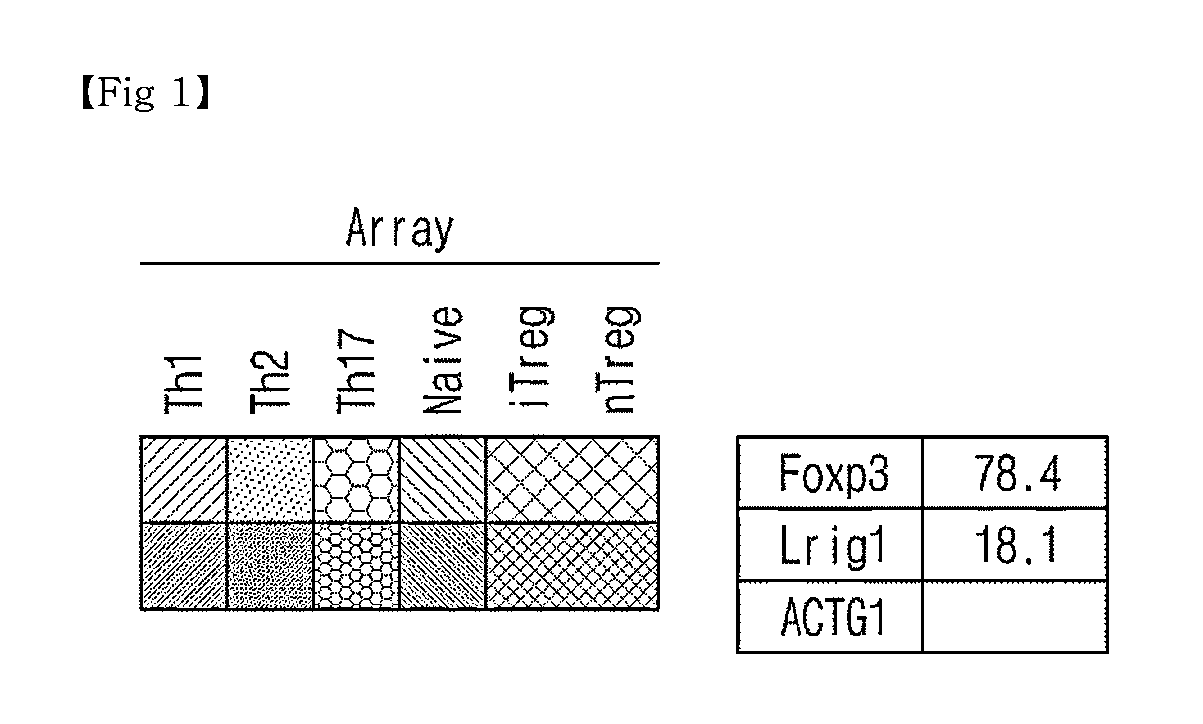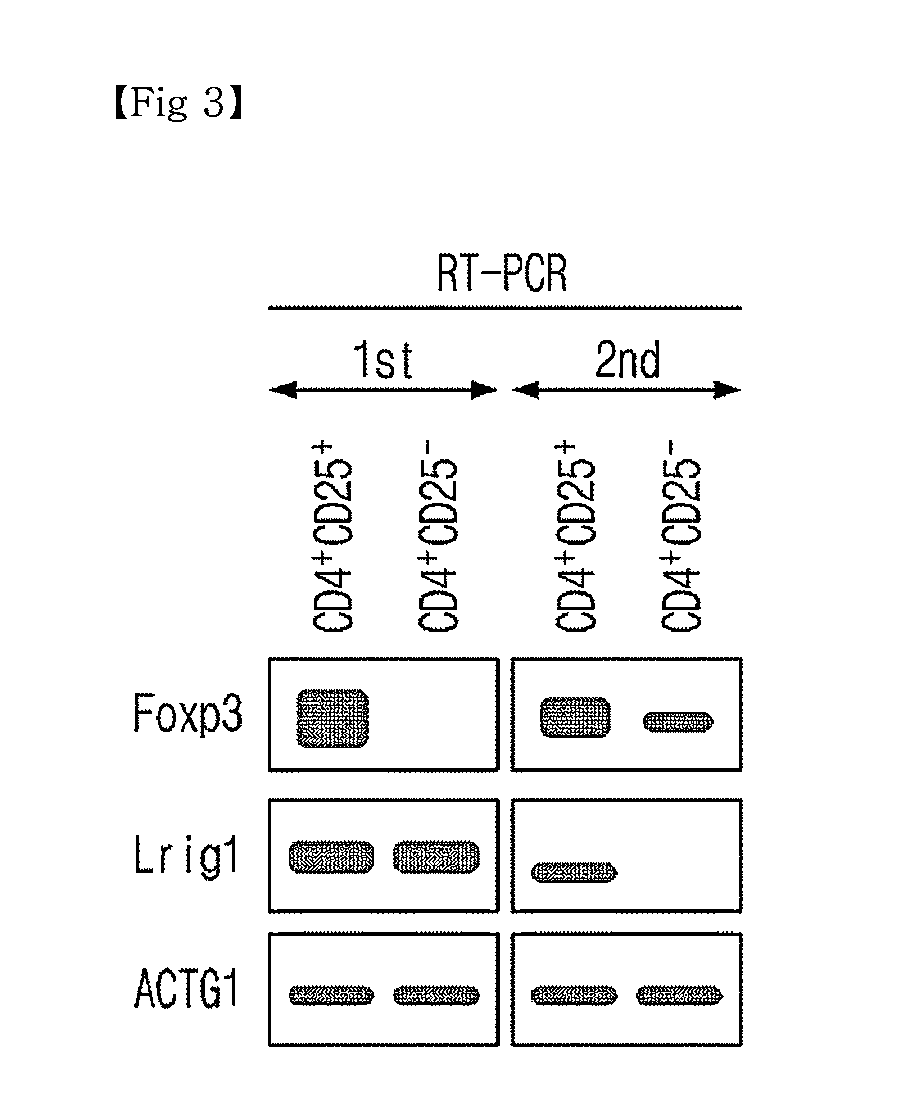Novel Use of Regulatory T Cell-Specific Surface Protein LRIG-1
- Summary
- Abstract
- Description
- Claims
- Application Information
AI Technical Summary
Benefits of technology
Problems solved by technology
Method used
Image
Examples
example 1
Isolation and Culture of T Cells
[0067]C57BL6 (H-2b) wild-type mice and Foxp3-GFP transgenic mice were used. All mice were bred in a clean condition (SPF) where the temperature and humidity were properly adjusted, and was used at the period of 8-12 week age in accordance with the animal experiment protocol approved by the Animal Experiment Commission of Yonsei University in Seoul.
[0068]The spleen cells of C57BL6 rats were isolated to which the antibodies attached with anti-CD4-magnetic bead was added and passed through a magnetic activated cell analyzer (MACS) (MiltenyiBiotee), thus isolating CD4+-cells (90-95%). Nest, in order to conduct MicroAnmy, the CD4+ cell ere stained with anti-CD4-antibody (Clone RM4-5, BD bioscience), anti-CD25-antibody (Clone 7D4, BD bioscience), anti-CD44-antibody (Clone IM7, BD bioscience) and anti-CD62L-antibody (Clone MEL-14, BD bioscience), and then non-contacted T cells (Naive T cells), CD4+CD62L+CD44−CD25−, natural regulatory T cells (nTreg), CD4+CD2...
example 2
Identification of Lrig-1 Surface Protein Specifically Expressing to CD4+CD25+ nTreg
[0075]Cells isolated from Example 1, i.e., CD4+CD25high cells, CD4+CD25low cells and CD4+Foxp3+ cells were dissolved with RIPA cytolysis buffer (Sigma). The same amount of cell suspension was then subjected to electrophoresis through SDS PAGE gel and moved into the membrane. Western blot was conducted using anti-LRIG1-antibody (SantaCruz), anti-Foxp3-antibody (ebioscience), and anti-beta actin (Cell Signaling).
[0076]To the cells isolated with a flow cytometry through a surface protein staining, i.e., CD4+CD25high cells and CD4+CD25low cells, anti-LRIG-antibody (R&D systems) and control antibody (Goat-IgG control, R&D systems) were added to compare the expression level of LRIG, reacted at a temperature of 4° C. for 30 minutes and then washed with FACS buffer (0.05% sodium azide, 0.5% BSA / PBS). The flow cytometric analysis was conducted with the flow cytometry (FACSCalibur, BD Bioscience)
example 3
Identification of the Relationship Between Lrig-1 Expression in Treg and Treg Proliferation
[0077]Mouse Lrig1-specific siRNAs (Thermo Fisher Scientific) was prepared into a liposome-siRNA complex (Lipofectamin 2000™ Invitrogen) and the amount of final siRNA was made as 5-50 pmol and then transfected in proliferated CD4+Foxp3+ T cells 1×105 / 2 ml cell culture solution. After 24 hours, the reduction of expression was confirmed through the reverse transcription polymerase chain reaction. The Lrig1-specific siRNAs sequences used are as follows:
TABLE 2siRNA for expression inhibitionSEQ ID NONameSequence7SMARTpool siRNA CCGAACGGCCUGCGUAUAAJ-046693-098SMARTpool siRNA GGAGCCAGCUGAAGUCGUAJ-046693-109SMARTpool siRNA GGUCUGUAGUUGAGGACGAJ-046693-1110SMARTpool siRNA CCUGGAAGGUGACGGAGAAJ-046693-12
PUM
| Property | Measurement | Unit |
|---|---|---|
| Surface | aaaaa | aaaaa |
| Level | aaaaa | aaaaa |
Abstract
Description
Claims
Application Information
 Login to View More
Login to View More - R&D
- Intellectual Property
- Life Sciences
- Materials
- Tech Scout
- Unparalleled Data Quality
- Higher Quality Content
- 60% Fewer Hallucinations
Browse by: Latest US Patents, China's latest patents, Technical Efficacy Thesaurus, Application Domain, Technology Topic, Popular Technical Reports.
© 2025 PatSnap. All rights reserved.Legal|Privacy policy|Modern Slavery Act Transparency Statement|Sitemap|About US| Contact US: help@patsnap.com



